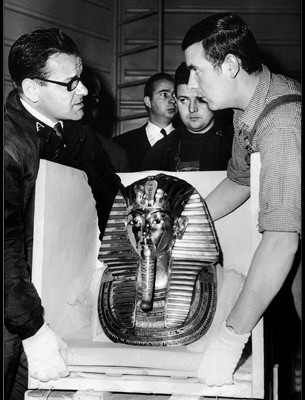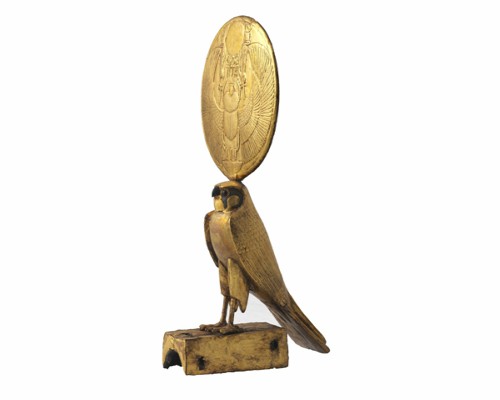Tutankhamun fever hit the French capital this week as Paris is welcoming the “Tutankhamun, the Treasures of the Pharaoh” exhibition on its second leg after Los Angeles in the US as part of a worldwide tour.
The features of the golden boy-king can be seen everywhere in the city centre, including in metro stations, shops, restaurants and outside residential buildings.
Meanwhile, the golden sarcophagus of Tutankhamun has caught the front pages of many French newspapers and magazines, some of which have devoted issues to Tutankhamun’s treasures, history, and the discovery of his tomb.

Gilded statuette of god Horus (Photo: Vincent Nageotte)
The collection of the young Pharaoh is back in Paris, 52 years after its last visit in 1967 when more than 1.2 million visitors gathered to admire 45 objects from the boy-king’s collection exhibited in the Petit Palais.
Managing director for exhibitions at the IMG company that organised this year’s show, John Norman, said the exhibition was like none that had been seen before.
Millions of people around the world would get the opportunity to see these ancient objects in an immersive context, he said, adding that “Tutankhamun’s place in people’s imaginations will be secure for generations to come.”

The mask exhibited in 1967
According to the organiser of the exhibition, some 130,000 tickets had been sold, and it is expected that this will reach 150,000 tickets before the public opening of the exhibition at the Grande Halle de la Villette on 23 March.
A VIP inauguration by Egypt’s Minister of Antiquities Khaled El-Enany is to be held on 21 March.
The immersive exhibition will unveil more than 150 artefacts from the tomb of Tutankhamun over the next six months. More than 50 pieces from this collection have travelled for the first time out of Egypt.
It is a unique opportunity for worldwide audiences to rediscover the history of one of the most perplexing kings in ancient Egyptian history who lived almost 3,300 years ago as well as many of the personal belongings of the young sovereign that accompanied him in the two worlds of life and death.
These will be exhibited within the Grand Egyptian Museum (GEM) that is currently under construction overlooking the Giza Plateau and is scheduled to open in 2020.
Visitors will be able to learn about how scientific analysis of the Pharaoh’s 3,000-year-old mummy has revealed new information about his health and lineage, as well as how cutting-edge archaeological tools have assisted in discovering tombs and analysing existing ones in ways never before imagined.
The discovery of the tomb and the history of Egyptian archaeology, along with new scientific analysis of the mummy, will be also shown through a video exhibition in the show presenting scan data of Tutankhamun’s mummy.

The god Horus with the sun-disk
New DNA testing shows that the young Pharaoh suffered from malaria and had a badly broken left leg above the knee that pierced his skin. This likely resulted in the infection that caused his death.
The exhibition also takes visitors into the afterlife, visualising it through objects from Tutankhamun’s tomb. It combines technology, music and animation in novel ways.
“We have used a lot of technology in the exhibition,” Norman said, describing it as “a very theatrical experience”.
The most important artefacts on show include a 40cm gold coffin, the gold diadem from Tutankhamun’s mummy, a gold fan featuring an ostrich hunt, a small gold canopic coffin ornamented with faience, a silver trumpet used for religious ceremonies, a gilded wooden statuette depicting the king riding a black varnished leopard, four marble canopic jars, and a gilded wooden jackal-headed figurine with the god Duamutef on the base.
There is a wooden travelling chest with gilded knobs inlaid with ebony and ivory, gold finger rings with images of the god Amun-Re on a cartouche-shaped bezel, a marble game board, and tapestry woven linen gloves.
One iconic item in the exhibition is a statue of Ka, a wooden guardian statue with gilded head-dress and skirt, and other items including ushabti figurines, head-rests, boxes and jewellery.
“We had to change the 110 doors of the Grande Halle to hardened steel models to protect the works from the risk of fire and to ensure their safety. We also had to modernise the temperature conditions, since it was necessary to cool the room without air-conditioning, “ Didier Fusillier, head of the Grande Halle de La Villette, told the French newspaper Les Echoes.
“The works arrive from Los Angeles and only come out of their container inside La Villette. Cranes and trucks enter directly into the Grande Halle, which avoids the manipulation of objects.”

Tutankhamun posters decorating the buildings and streets in Paris
“We have equipped the crates with a SenseAware system, which provides information on geolocation and environmental conditions such as temperature and humidity,” Mathilde Goffard, vice president of land operations at FedEx France, told the newspaper.
Elham Salah, head of the Museums Sectors at the ministry, said the collection had been insured for $800 million.
It would be accompanied by an officer from Egypt’s Tourist and Antiquities Police, a restorer and a curator, she said, adding that the revenue from the exhibition was estimated at $50 million for each country involved, and there would also be a percentage paid on the number of tickets and souvenirs sold.
The ministry would benefit from 10 per cent of the value of the items sold, as well as $1 for each visitor above 400,000, reaching $4 per visitor at 700,000 visitors.
“The exhibition arrived in Los Angeles in March 2018, and it is now in Paris as a message of peace from the Egyptians to the whole world to show how the ancient Egyptians built their own great civilisation with passion, faith, love, knowledge and art,” El-Enany said.
“It will allow humanity to admire our treasures and encourage visitors to come to see the fascinating monuments in their original context in Egypt,” he added.
Other legs of the exhibition include the Saatchi Museum in London, the Smithsonian Museum in Washington, the Sydney Museum in Australia, the National Museum in South Korea, the Franklin Institute in Philadelphia, the Field Museum in Chicago, the Muri Art Centre in Tokyo and the Osaka Museum of Art.
The French TV channel France2 described the Tutankhamun exhibition as the most important cultural event in Paris for years, while the one held in 1967 “was the most beautiful Christmas gift” imaginable, it said.
Recalling the 1967 exhibition, Jean-Marc Gonion, the editor of Le Figaro magazine, told Tarek Al-Awadi, the curator of the exhibition, that although he was young at that time he remembered that his parents had left him at his grandmother’s house so he would not stand queuing at the Petit Palais to explore the treasures of the Egyptian boy-king.
He was very happy to have a chance to see the exhibition on its return to Paris 50 years later, he said, adding that in the queues for the exhibition in 1967 some marital problems had been solved while other couples had been divorced. New friendships had been created, and some bachelors had found marriage, he said.
*A version of this article appears in print in the 21 March, 2019 edition of Al-Ahram Weekly under the headline: Tutankhamun comes to Paris
Short link: